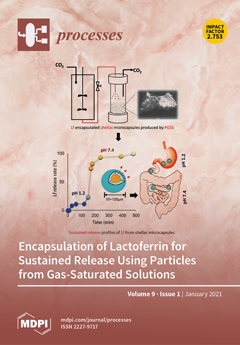Biobutanol can be produced by Clostridia via an acetone–butanol–ethanol (ABE) fermentation under strictly anaerobic conditions. Oxygen-free nitrogen (OFN) gas is typically used to create anaerobic conditions for ABE fermentations. However, this method is not appropriate for large-scale fermentations as it is quite costly.
[...] Read more.
Biobutanol can be produced by Clostridia via an acetone–butanol–ethanol (ABE) fermentation under strictly anaerobic conditions. Oxygen-free nitrogen (OFN) gas is typically used to create anaerobic conditions for ABE fermentations. However, this method is not appropriate for large-scale fermentations as it is quite costly. The aim of this work was to study the feasibility of butanol production from sweet sorghum juice (SSJ) by
Clostridium beijerinckii TISTR 1461 using various methods to create anaerobic conditions, i.e., growth of a strictly aerobic bacterium, an
Arthrobacter sp., under different conditions and a chemical method using sodium dithionite (SDTN) to consume residual oxygen. SSJ containing 60 g/L of total sugar supplemented with 1.27 g/L of (NH
4)
2SO
4 was used as a substrate for butanol production. The results showed that 0.25 mM SDTN could create anaerobic conditions, but in this case,
C.beijerinckii TISTR 1461 could produce butanol at a concentration (
PB) of only 8.51 g/L with a butanol productivity (
QB) of 0.10 g/L·h.
Arthrobacter sp. BCC 72131 could also be used to create anaerobic conditions. Mixed cultures of
C.beijerinckii TISTR 1461 and
Arthrobacter sp. BCC 72131 created anaerobic conditions by inoculating the
C.beijerinckii 4 h after
Arthrobacter. This gave a
PB of 10.39 g/L with a
QB of 0.20 g/L·h. Comparing butanol production with the control treatment (using OFN gas to create anaerobic conditions, yielding a
PB of 9.88 g/L and
QB of 0.21 g/L·h) indicated that using
Arthrobacter sp. BCC 72131 was an appropriate procedure for creating anaerobic conditions for high levels of butanol production by
C. beijerinckii TISTR 1461 from a SSJ medium.
Full article





